On March 16, 2023, the U.S. Copyright Office issued guidance on how it considers applications for works containing expressive material generated by artificial intelligence (AI).
AI technology is not brand new. The Office has reviewed and denied applications claiming AI authorship or co-authorship for years on the ground that only humans may own copyrights (known as the "human authorship requirement"). The sudden public awareness and widespread availability of sophisticated generative AI has, however, sparked an explosion in copyright applications claiming content created wholly, in part, or with at least minimal assistance of AI. This increased attention prompted the Office's guidance.
Human Authorship in AI: the "Creative Control" and "Actually Formed" Test
The Office stated that AI-generated expressive material can indeed "contain sufficient human authorship to support a copyright claim" and be registrable. "What matters is [1] the extent to which the human had creative control over the work's expression and [2] 'actually formed' the traditional elements of authorship." "For example, a human may select or arrange AI-generated material in a sufficiently creative way that 'the resulting work as a whole constitutes an original work of authorship.'"
No Human Authorship in AI Where "Traditional Elements of Authorship Were Produced By A Machine"
The Office found that a "prompt," i.e., a textual instruction provided by a user to an AI technology, does not meet the human authorship requirement and is therefore not registrable. For example, where "a user instructs a text-generating technology to 'write a poem about copyright law in the style of William Shakespeare,'" the Office found that the "AI technology determines the expressive elements of its output," (i.e., "the rhyming pattern, the words in each line, and the structure of the text") and thus "the generated material is not the product of human authorship." The prompts instead "function more like instructions to a commissioned artist—they identify what the prompter wishes to have depicted, but the machine determines how those instructions are implemented in its output."
Duty to Disclose AI's Contributions
The new guidance also states that Applicants seeking to register a copyright now have "[1] a duty to disclose the inclusion of AI-generated content in a work submitted for registration and [2] to provide a brief explanation of the human author's contributions to the work." The guidance further advises that "AI-generated content that is more than de minimis should be explicitly excluded from the application" through the "Limitation of the Claim" section of the application. The guidance also provided a procedure for correcting pending applications, stating "applicants should contact the Copyright Office's Public Information Office and report that their application omitted the fact that the work contained AI-generated material."
Forthcoming Notice of Inquiry on AI Training and Results
The Office indicated that it intends to publish a notice of inquiry later this year seeking public input on additional topics, including "how the law should apply to the use of copyrighted works in AI training and the resulting treatment of outputs."
Case Study: Zarya of the Dawn—When Human Authorship Exists in AI Generated Works (and When It Doesn't)
The Office's decision regarding the registrable and nonregistrable AI-based components of the Zarya of the Dawn graphic novel provides a helpful framework for thinking about the Office's guidance.
Background
On February 21, 2023, the Office reissued a registration certificate for Zarya of the Dawn (the Work) (Reg. No. Vau001480196), a webcomic authored by Kristina Kashtanova, as a result of Kashtanova's failure to disclose that she used images created with the assistance of an AI-based image generation technology, Midjourney.
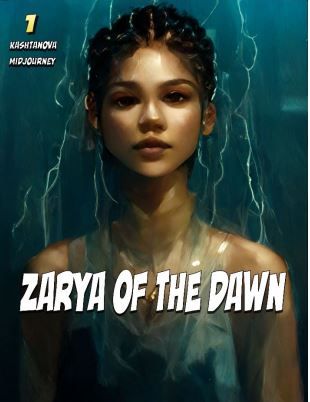
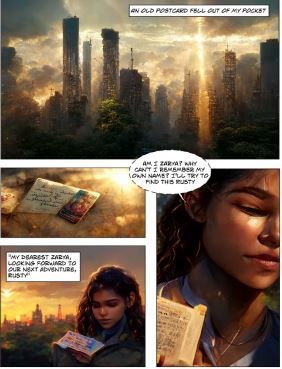
Midjourney is an AI technology that operates on top of third-party communication service, Discord. Midjourney is capable of generating images in response to text provided by a user like Kashtanova, i.e., prompts. Users also have the option to include "(1) a URL of one or more images to influence the generated output, or (2) parameters directing Midjourney to generate an image in a particular aspect ratio or providing other functional directions." "After a user provides Midjourney with a prompt, the technology will generate four images in response. The images are provided in a grid, and buttons underneath the grid allow users to request that Midjourney provide a higher-resolution version of an image," "create new variations of an image," "or to generate four new images from scratch" "For example, entering the prompt '/imagine cute baby dinosaur shakespeare writing play purple' resulted in the following response from Midjourney:
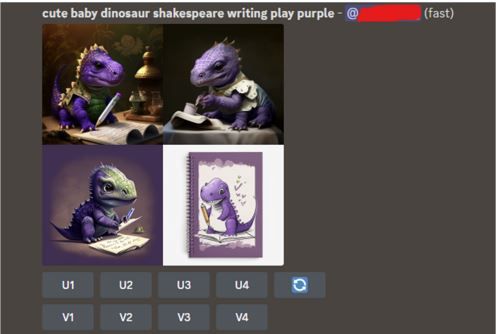
The Office Finds Sufficient Human Authorship in Text and Arrangement, But Not In Individual Images
In reexamining the Work, the Office found that Kashtanova is the author of the Work's text because it was "written entirely by Kashtanova without the help of any other source or tool, including any generative AI program." The Office found that the text of the Work was the product of human authorship and is thus protected by copyright.
In contrast, the Office concluded that the images generated by Midjourney were not the product of human authorship. Although Kashtanova claimed that she "guided" the structure and content of each image (i.e., by entering a text prompt, selecting images to further develop, tweaking prompts, and selecting a final image), "it was Midjourney—not Kashtanova—that originated the 'traditional elements of authorship' in the images." Kashtanova did not "actually form" the images and was not the "master mind" behind them simply by providing prompts to Midjourney. To generate images, Midjourney starts with "a field of visual noise, like television static," and then uses "an algorithm to refine that static into human-recognizable images." "While additional prompts applied to one of these initial images can influence the subsequent images, the process is not controlled by the user because it is not possible to predict what Midjourney will create ahead of time." Thus, "information in the prompt may 'influence' generated image, but prompt text does not dictate a specific result."
In response, Kashtanova argued that that Midjourney was a tool that she used to control and guide the process (like Adobe Photoshop). The Office rejected this argument because "Midjourney generates images in an unpredictable way." "It is therefore understandable that users like [] Kashtanova may take 'over a year from conception to creation' of images matching what the user had in mind because they may need to generate 'hundreds of intermediate images.'"
The Office also considered Kashtanova's personal editing of certain images created by Midjourney, concluding that while such images are theoretically subject to copyright protection, Kashtanova's edits were not sufficient for several reasons.
First, Kashtanova "modif[ied] the rendering of Zarya's lips and mouth" in the below image comparison, but the Office found these changes "too minor and imperceptible to supply the necessary creativity for copyright protection." The edited work must contain a "sufficient amount of original authorship" to itself qualify for copyright protection.
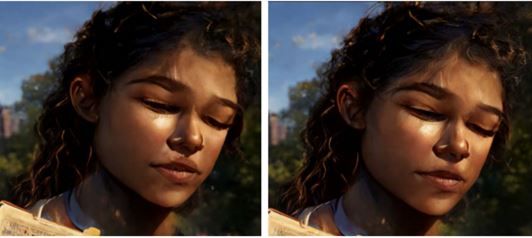
Second, Kashtanova pointed to the images below, created "using both the Midjourney service and Photoshop together," with edits in Photoshop made to "show[] aging of the face, smoothing of gradients[,] and modifications of lines and shapes." The Office stated that "[t]o the extent that [] Kashtanova made substantive edits to an intermediate image generated by Midjourney, those edits could provide human authorship and would not be excluded from the new registration certificate." (emphasis added). But here the Office could not "determine what expression in the image was contributed through her use of Photoshop as opposed to generated by Midjourney" and thus denied copyright protection.
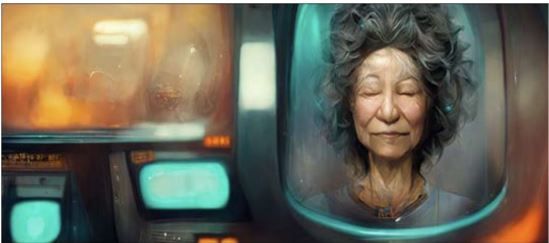
With respect to selection and arrangement of the images and text in the Work, the Office found that they are protectable as a compilation because Kashtanova "selected, refined, cropped, positioned, framed, and arranged" the images in the Work "to create the story told within its pages." Because the selection, coordination, and arrangement of the Work's written and visual elements was done entirely by Kashtanova, those elements had enough human authorship to be protected by copyright. This is the precise example provided in the Office's guidance.
The Office concluded its review by noting that the prior registration did not disclaim the Midjourney-generated content. The Office thus cancelled the original registration and reissued a certificate covering only the text and arrangement.
The "Copyright Registration Guidance: Works Containing Material Generated by Artificial Intelligence" can be found here: https://www.federalregister.gov/documents/2023/03/16/2023-05321/copyright-registration-guidance-works-containing-material-generated-by-artificial-intelligence.
The Office's full letter reregistering the Zarya of the Dawn copyright can be found here: https://copyright.gov/docs/zarya-of-the-dawn.pdf.
The content of this article is intended to provide a general guide to the subject matter. Specialist advice should be sought about your specific circumstances.

